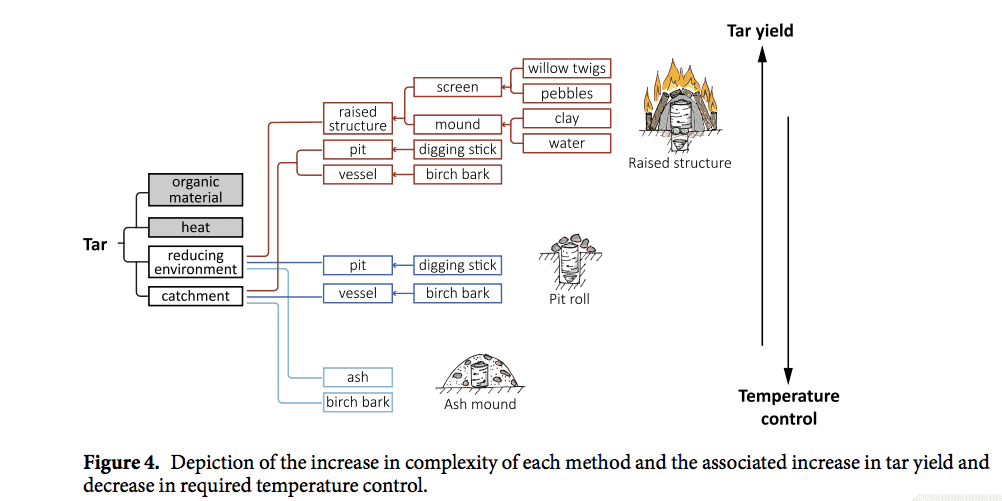With their heavy brows and brutish appearance, Neanderthals (Homo neanderthalensis) seem to have been inferior to humans. But we all know looks can be deceiving. After all, it’s prejudices like these that can give birth to racism. Moreover, some people have even tried to use the scientific method to justify their racism.
Concerning our very close cousins, with each passing day, it seems like many of our assumptions, some subject of inter-species prejudice, are just wrong. One new study proves, for instance, that Neanderthals were distilling tar which they used to fashion tools some 200,000 years ago. It’s even questionable whether Homo sapiens even appeared around that time.
Could a brute make these?

Scientists learned of this fact after discovering tar beads in Italy, Germany, and other sites around Europe which were far older than the earliest signs of humans in Western Europe. The only explanation is that these were likely made by Neanderthals.
Tar is a huge technological breakthrough that enabled humans, and obviously, Neanderthals, to make superior tools. With this adhesive at hand, people could now assemble axes, hammers or any other machinery out of multiple parts.
There were some loose ends, though. We know that humans used to make tar ceramic vessels where tree bark was heated to around 350°C. The earliest archaeological evidence we have of ceramics is from 20,000 years ago, though.
The team of archaeologists at Leiden University, Netherlands, led by Paul Kozowyk investigated the lead by testing three scenarios for making tar from birch bark. The researchers were careful to only use technology that was available, from what we know of, to the Neanderthals. Ars Technica‘s Annalee Newitz describes one of the methods tested by the team:
“In the “ash mound” method, a roll of birch bark is heated under a pile of ash and embers. Tar is extruded into a birch bowl. In the “pit roll” method, a tube of birch bark is inserted into a narrow pit, and fire is lit on top. Tar drips from the roll onto a rock at the bottom of the pit. And finally, in the “raised structure” method, a birch bowl is placed in a shallow pit, under a screen woven from green willow wood. A roll of birch sits atop the screen and is then buried under dirt. Fire is lit on top of the dirt, slow-cooking the birch bark.”

All three methods rendered a couple grams of tar which is consisted with the findings from the archaeological sites, though they varied in complexity. The raised structure method required the most fire wood while the pit roll technique was simpler and required fewer resources but yielded little tar. Remarkably, they were also able to make tar at temperatures below 200 °C. This showed that Neanderthals didn’t need ceramics nor the technology to maintain a constant temperature to make tar.
It’s very likely that Neanderthals discovered tar making by accident. The researchers speculate in Nature Scientific Reports that it’s not unreasonable for Neanderthals to see tar dripping from bark thrown in the fireplace only for them to later attempt to manufacture their own after becoming impressed by its properties.
“In this way, they could develop the technology from producing small traces of tar on partially burned bark to techniques capable of manufacturing quantities of tar equal to those found in the Middle Palaeolithic archaeological record,” the authors concluded.
This is just the latest in a string of archaeological findings that demonstrate the intellectual prowess and social nature of Neanderthals. At the Croatian site of Krapina, anthropologists found a beautiful a set of eagle talons that included cut marks and were fashioned into a piece of jewelry. Neanderthals practiced cave painting and lit fires way before humans. The first instance of pre historic dentistry from about 130,000 years ago may have also been Neanderthal work. They even used manganese dioxide, today commonly found in batteries, to light fires some 50,000 years ago.
We can’t be sure that Neanderthals were the first to essentially invent glue. Maybe early humans in Africa independently arrived at the same discovery but there’s no evidence yet to back this up. In the meantime, no one can take this remarkable achievement away from Neanderthals who were far more complex than many care to give them credit.






